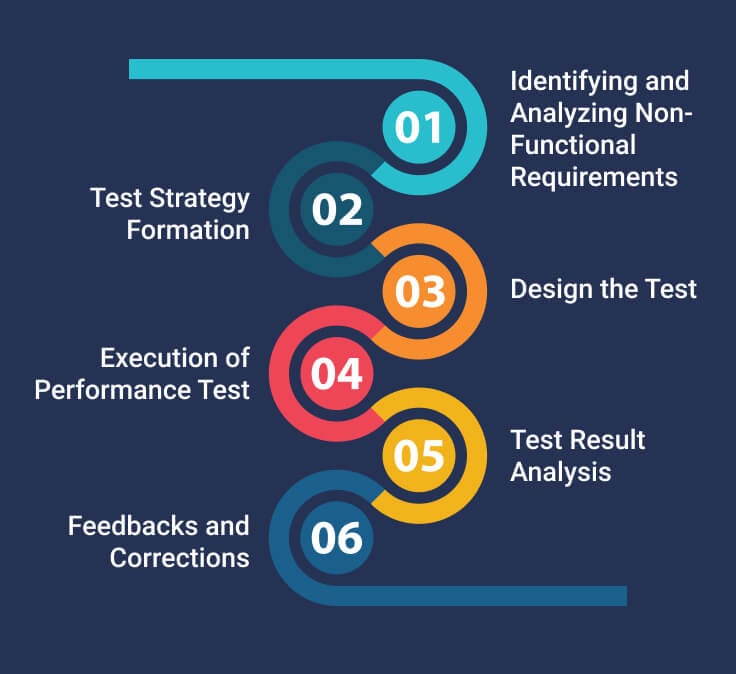Introduction to Performance Testing
The performance of any application determines how the user will react to it. Let’s look at a situation where we’re asked to perform more than one task at a time. What exactly happens? The mind gets stuck and is unable to process information. A similar situation exists with an application. A system failure can be costly and harm your company’s image.
Performance testing will assist you in achieving a streamlined performance for your application. This type of testing assures that your application is available during important transactions. It evaluates an application’s responsiveness, throughput, speed, stability, and scalability.
In many industries such as banking, healthcare, and telecommunications, day-to-day transactions are critical. Wherein, many businesses may be concerned about issues such as:
- How much time does it take for a transaction to complete?
- Ways to achieve necessary throughput for heavy traffic?
- How do you create a successful IT application?
The correct test strategy can answer these questions. Let’s take a look at the various types of performance testing. Which can help you develop a successful performance testing strategy.
Major types of Performance Testing
Stress Testing
Stress testing evaluates an application’s performance characteristics. It exposes the application to conditions that are not defined during development. Tester conducts such tests to determine the system’s largest load capacity before it crashes. This form of testing involves pushing an application above its usual load limits to see which components fail.
Load Testing
Load testing checks an application’s performance in high traffic. Heavy load, or as we say, an increased number of users, is applied to the software during the tests. And the results are measured to see if the app fulfills all the requirements.
Load is defined as the expected number of concurrent users on the application performing a given number of transactions within a specified time frame. If other components such as the database and application server are checked, this simple test might also show other problems in the application software.
Endurance Testing
Endurance testing evaluates an application under load for a longer duration. This verifies the performance requirements related to production loads and their durations. Applications are subjected to endurance tests by applying various loads over a prolonged length of time. The program must be able to withstand a higher load without decreasing reaction times.
Spike Testing
Spike testing checks the way an application handles a sudden rise in volume. The increase in volume occurs with a sudden rise in the load generated by many users. This sort of performance testing is done to see how the system will manage a sudden increase in load and if it will fail or not.
Companies that look forward to experiencing many users can take advantage of spike testing. E.g., customer service, medical emergencies, etc.
Volume Testing
Another name for volume testing is flood testing. The goal of volume testing is to check the performance of the application is not affected when exposed to high volumes of data. This testing focuses on application response time and application behavior.
The purpose of volume testing is to identify obstacles and assess the system’s capabilities. Big data applications need such evaluation.
Scalability testing
Scalability testing is conducted to verify whether your application can manage rising loads and processing. The test helps measure response time, throughput, requests per second, Network usage, etc.
Another goal for scalability testing is to check if the server can cope or crash under a heavy load. The results of this testing can be incorporated in the planning and design phases of development, lowering costs and reducing the risk of performance problems.
Performance Testing Goals
There are three major goals for performance testing.
Page Speed
Users get attracted to a smooth-going process. For that, they expect the pages to load quickly. Users may get annoyed and lose trust if the website malfunctions. It also creates problems if the system takes an eternity to load, leading to an unpleasant experience. The faster the website is, the better its performance will be. To keep customers on your site and away from your competitors, it’s essential to have a fast load time because everything on the internet is just a click away.
Scalability
Along with good speed, scalability is also an essential factor for application performance. Your app’s scalability refers to its ability to handle an increasing number of customers, clients, or users. If there are problems with the program, adding new features will result in a deadlock.
The scalability of your application positively impacts your users as the app can handle the traffic surges, which helps in achieving a higher rate of interest from your application.
Stability
None of the companies want their applications to crash, especially at a crucial moment. As it can cost them a fortune as well as lose their customers. E.g., if there is a gaming tournament going on, the gaming company cannot afford the app to crash in the middle of the game. In such scenarios, stress testing is essential. It is vital to get the idea of how many users your app can handle before it crashes.
Tools for Performance testing
There are great tools available for performance testing in the market. The purpose of conducting performance testing is to establish how efficiently the system runs under different workloads. Automated testing tools help conduct the test most effectively.
Each tool is different in its capability and scope. These tools test the applications on various factors like performance testing, GUI testing, functional testing, etc. Tools that are in demand, easy to learn, and effective for the testing requirement are recommended for use. Let’s have a look at some of the testing tools:
Apache JMeter
Apache JMeter is a java-based open-source tool for testing Web applications. It has recently been updated to incorporate additional test functions. The tool examines and evaluates an application’s performance in a variety of ways. In comparison to other tools, it takes less time to script. Apache JMeter tool can be used to assess the performance of static and dynamic resources and Web dynamic applications.
The tool is used to simulate a heavy demand on a server, a set of servers, a network, or an object to test its strength or examine overall performance under various load types.
LoadNinja
This tool allows scriptless tests. These scripts are large, difficult to comprehend, and need a dynamic correlation of session status to playback, making load testing a time-consuming and exhausting endeavor. By automating the difficult jobs of dynamic correlation, script translation, and script scrubbing, LoadNinja allows teams to improve test coverage without sacrificing quality.
WebLOAD
WebLOAD is a load testing tool for large organizations. It comes with an integrated development environment (IDE), a load generation console, and an advanced analytic dashboard.
The tool makes flexible test scenarios, a Powerful correlation engine, automated problem detection, and more.
LoadView
DevOps teams can use the tool to stress test their websites, web apps, and APIs with thousands of simultaneous connections in real browsers. That, too, all from a fully managed cloud environment. It generates multi-step scripts that act as if consumers are interacting with your website or application. You can display the actual performance of your applications under load using Dotcom-LoadView Monitor’s tool.
LoadUI Pro
LoadUI Pro can monitor application servers by increasing the pressure on them. This tool helps in the faster design of load tests without scripts and distributing them on-cloud using load. One can make load tests automatic, and you can receive complete reports.
Performance Testing Life Cycle (PTLC)
Performance Testing is performed along with software development. The different phases of the Performance Testing Life Cycle (PTLC) are:
- Identifying and Analyzing Non-Functional Requirements
- Test Strategy Formation
- Design the Test
- Execution of Performance Test
- Test Result Analysis
- Feedbacks and corrections
Phases of the Performance Testing

Benefits of Performance Testing
- Verify the software’s essential functionality.
- Software is tested for speed, accuracy, and stability.
- Identifies if there are any issues and resolves them.
- You can keep your consumers pleased by performing performance testing.
- Optimization and load capacity gets improved.
- A streamlined user experience helps companies to improve their customer reach.
Organizations are adopting outsourcing teams to work on their projects which include the software testing teams as well. In such circumstances, Openxcell’s outsourcing teams can be a great help. Performance testing is beneficial to make your application successful. Get the best out of it.








